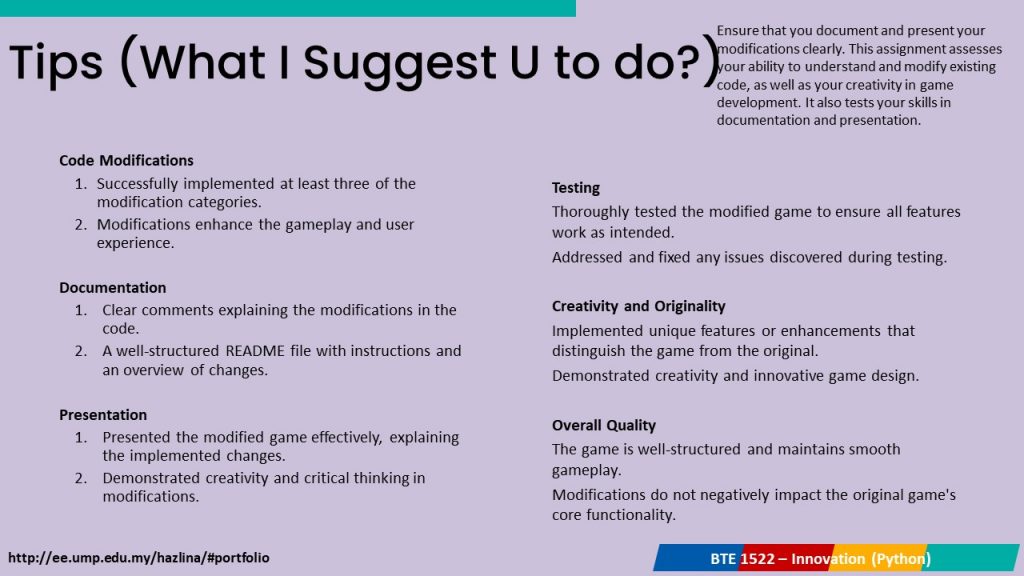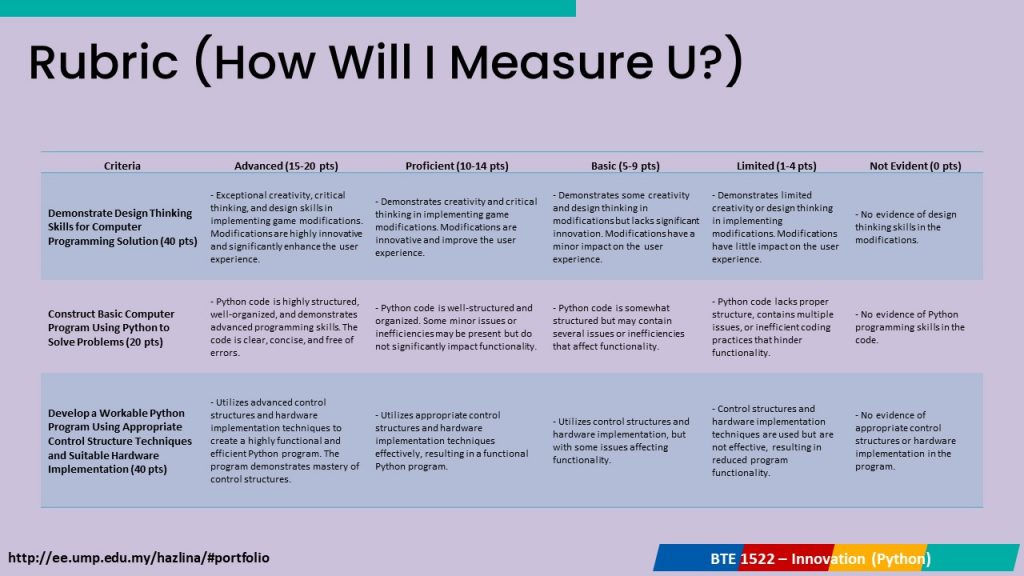Hi BTE-ian,
This assignment is part of your class assessment. Do this in pair.
So, what exactly does this assignment entail? Let’s break it down:
Assignment Overview
1. Choose Your Innovation
Your first task is to select one innovation from a list of exciting options. Whether you’re drawn to the idea of introducing power-ups, implementing different difficulty levels, or designing a boss battle, there’s something for everyone. Discuss with your partner and choose the innovation that excites you the most.
The challenges are:-
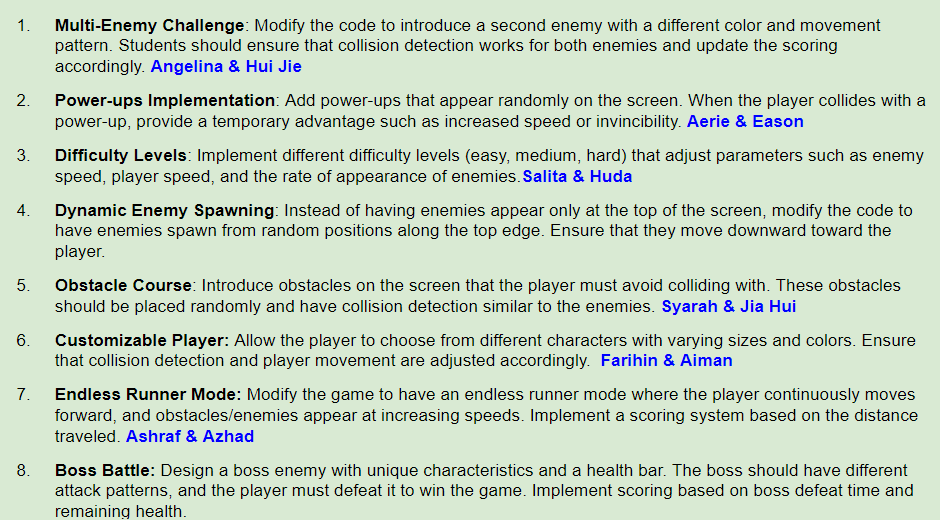
- Multi-Enemy Challenge: This challenge involves modifying the Slider Game code to introduce a second enemy with a different color and movement pattern. In this innovation, students will need to expand the game’s enemy mechanics to accommodate the presence of two distinct enemies on the screen simultaneously. This may require creating separate variables to track the position, color, and movement patterns of each enemy. Additionally, students must ensure that collision detection is updated to detect collisions with both enemies and adjust the scoring system accordingly. This innovation adds complexity to the game by introducing diversity in enemy types, enhancing the gameplay experience and providing players with new challenges to overcome.
- Power-ups Implementation: This challenge involve implementing power-ups into the Slider Game. Power-ups are special items that appear randomly on the screen and provide the player with temporary advantages when collected. This innovation requires students to design power-up objects with unique properties such as increased speed or invincibility. They must integrate logic to spawn power-ups at random intervals and locations on the screen. When a player collides with a power-up, they should experience the temporary advantage granted by the power-up. This addition adds an element of strategy to the game as players must strategically collect power-ups to gain an edge over the obstacles and enemies they encounter.
- Difficulty Levels: This challenges focuses on implementing different difficulty levels in the Slider Game. This innovation involves adjusting various parameters such as enemy speed, player speed, and the rate of appearance of enemies to create different levels of challenge for players. Students will need to introduce logic to dynamically adjust these parameters based on the selected difficulty level (easy, medium, or hard). Easy levels may feature slower enemies and fewer obstacles, while hard levels may ramp up the speed and frequency of enemy appearances. By providing players with a choice of difficulty levels, this innovation enhances the game’s accessibility and replay value, catering to a wider range of player skill levels.
- Dynamic Enemy Spawning: This task involves introducing dynamic enemy spawning into the Slider Game. Unlike the original game where enemies appear only at the top of the screen, this innovation involves modifying the code to have enemies spawn from random positions along the top edge. Students must ensure that enemies move downward toward the player, posing a continuous threat throughout the game. By introducing randomness into enemy spawning locations, this innovation adds unpredictability to the gameplay, requiring players to adapt quickly to changing enemy positions and movement patterns.
- Obstacle Course: This challenge involves implementing an obstacle course in the Slider Game. This innovation involves introducing obstacles on the screen that the player must avoid colliding with. Obstacles should be placed randomly and have collision detection similar to enemies. Students will need to design obstacle objects with collision detection mechanisms to detect collisions with the player. By adding obstacles, this innovation increases the complexity of gameplay, requiring players to navigate through a maze of hazards while avoiding both enemies and obstacles. This introduces a new layer of challenge and strategic decision-making for players.
- Customizable Player: This challenge involves implementing a customizable player feature in the Slider Game. This innovation allows players to choose from different characters with varying sizes and colors. Students will need to adjust collision detection and player movement mechanics to accommodate different player characters. By providing players with the ability to customize their avatar, this innovation enhances player engagement and personalization, allowing players to tailor their gaming experience to their preferences.
- Endless Runner Mode: This challenge involves to develop an endless runner mode for the Slider Game. In this mode, the player continuously moves forward, and obstacles/enemies appear at increasing speeds. A scoring system based on the distance traveled will be implemented to track the player’s progress. This innovation introduces a sense of urgency and excitement to the gameplay as players strive to survive for as long as possible while overcoming progressively difficult challenges. It also encourages ‘replayability’ as players compete to achieve higher scores with each playthrough.
2. Implement Your Innovation
Once you’ve chosen your innovation, it’s time to roll up your sleeves and get coding! Dive into the Slider Game codebase and make the necessary modifications to bring your innovation to life. This is where your creativity and problem-solving skills will truly shine as you navigate the intricacies of game development.
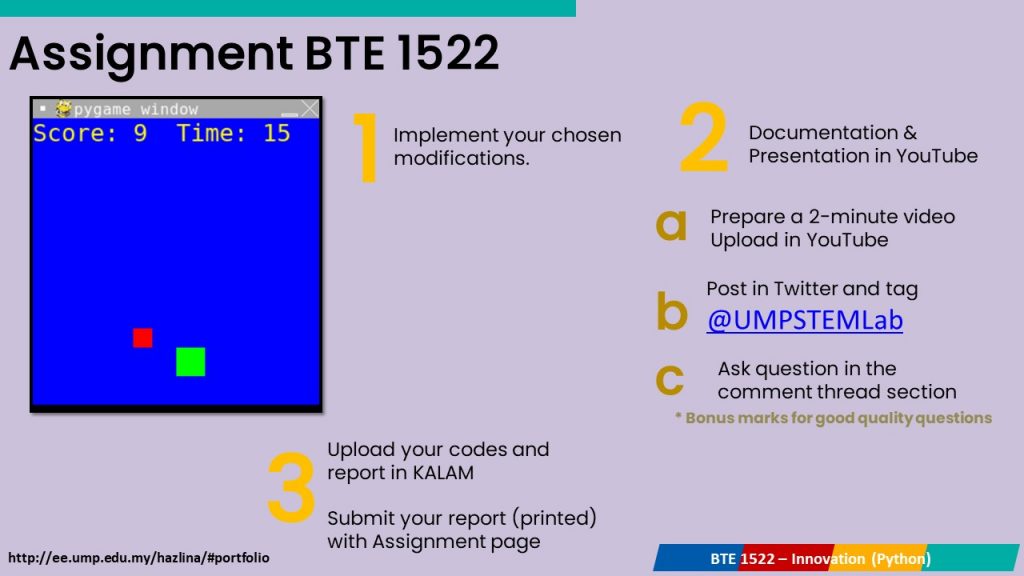
3. Record and Explain Your Changes
As you work on implementing your chosen innovation for the Slider Game assignment, don’t forget to document your progress with a video walkthrough. Explain the changes you’ve made and the thought process behind them. This not only solidifies your understanding of the code but also serves as a valuable learning resource for your peers.
Once your video walkthrough is ready, upload it to the @UMPSTEM Lab Twitter Twitter account. Here, you’ll have the opportunity to share your work with your classmates and receive feedback from them. Remember, engaging with your peers’ videos and leaving thoughtful comments will not only enhance your learning experience but also earn you bonus marks!
4. Prepare and Submit Your Report
Finally, compile your findings, explanations, and code into a comprehensive report. Your report should include an introduction, a description of the modification done, visual outputs (such as screenshots or diagrams), and a discussion of your findings. Be sure to submit your report on the KALAM platform and provide a hardcopy to your instructor before the deadline April 22nd 2024.
What’s the Aim of This Assignment?
Hands-On Learning: This assignment offers a hands-on opportunity to apply your Python programming skills in a real-world context. By working on a game development project, you’ll gain practical experience and deepen your understanding of Python concepts.
Creativity and Innovation: Choosing and implementing your innovation allows you to unleash your creativity and innovative thinking. Whether you’re designing new gameplay mechanics or enhancing existing features, this assignment encourages you to think outside the box and push the boundaries of what’s possible.
Collaboration and Communication: Working with a partner fosters collaboration and communication skills. Use this opportunity to exchange ideas, brainstorm solutions, and support each other throughout the development process.
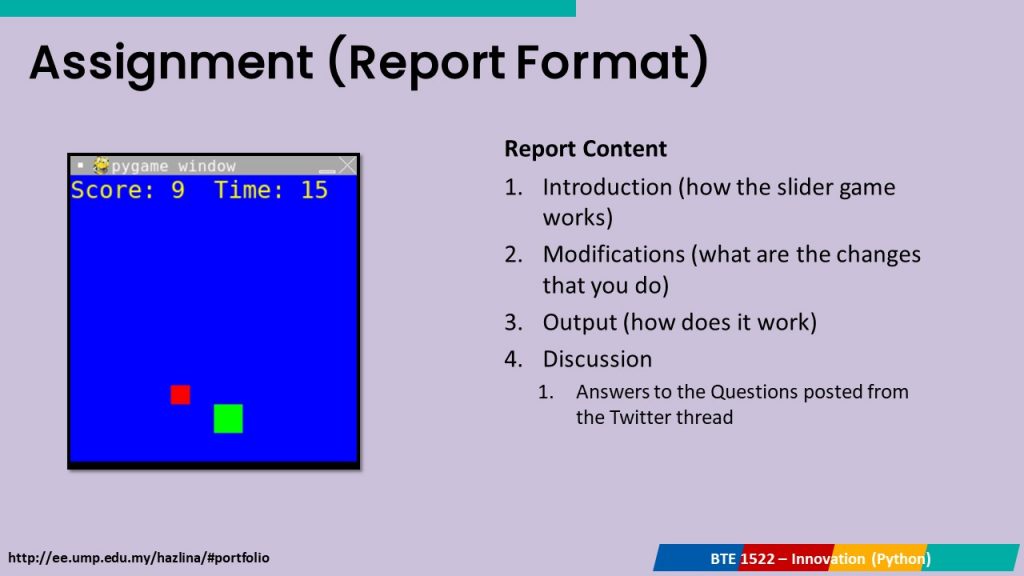
Personal Growth: As you tackle the challenges of game development, you’ll inevitably encounter obstacles and setbacks. Embrace these challenges as opportunities for growth and learning. Remember, every bug you squash and every feature you implement brings you one step closer to mastery.
This assignment is not just about coding—it’s about creativity, innovation, and personal growth. It’s about pushing yourself beyond your comfort zone and discovering what you’re truly capable of. So, embrace the challenge, unleash your imagination, and let’s make something amazing together!
I can’t wait to see the incredible innovations you’ll bring to life in the Slider Game. Remember, the sky’s the limit, and the journey ahead is bound to be an unforgettable one.
Happy coding, and may the Python be with you!
Nurul
